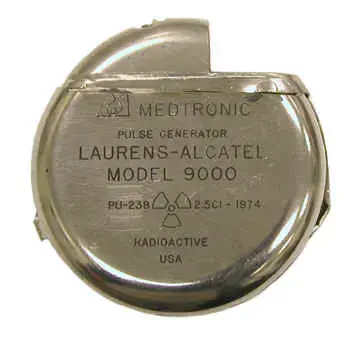In today’s episode of “weird shit I stumbled onto on the internet”, I bring you: nuclear-powered pacemakers.

Some of the earlier pacemakers made in the US, around the 70’s, were powered by a very small amount of plutonium. If you’ve ever heard of the term radioisotope thermoelectric generator or RTG in relation to eg. satellites, that’s what the pacemakers used. The upside of using an RTG was that the device could run for decades without needing to get its power source replaced. The downside is that you now have plutonium sown in to your chest cavity – which actually isn’t as bad as it sounds considering the amounts used, but it’s still a highly radioactive element and presents some fun challenges, some of which are discussed in the article.
Here’s an article on the technical details on how they, and thermoelectric kajiggers in general, work https://blog.plover.com/tech/seebeck-effect.html



I wish I remembered the details, but I read a couple years ago about new batteries using the same sort of principal.
It was being studied as a way to handle a specific part of radioactive byproduct from nuclear power.
You sandwich the tiny radioactive bit in materials to generate a charge, and the whole thing is encased in conductive man-made diamond.
A battery the size of a half dollar coin could generate roughly a watt of power for, ostensibly, up to hundreds of years.
The big seller beyond its lifespan is that the diamond is dense enough to shield the tiny amount of radiation inside.
Incredible potential that probably wont be realized in consumer goods for decades. Just think about never having to change the battery in a remote ever again. Or even a lot of wireless smart home sensors and devices.
A shocking amount of things take very little power. Air tags that never die. E-book readers. You could make super dim puck LEDs that are always on and can go anywhere for illuminating pathways.
You could never scale it much in size/output because the diamond encasing would become disproportionately heavy and expensive, but for anything 1.5 Watts and less, and possibly up to 3 Watts or so, could be totally feasible.
to put that into some interesting context that’s about what your cell phone uses if you go through the battery over 24hrs. With a battery or big capacitor to act as an accumulator you could in theory have a smart phone that never needs charging, or rarely when you use it a lot in one night.
This article poses the idea of a universal smartphone battery.
Remember when we could just remove and swap the battery? Now we could go back to that, removing the part where we charge it and the battery just… does it.
Not quite there yet, but holy hell this looks far more promising than most things we get. The idea of getting away from cell batteries entirely is… momentous.